A Study on the Thermal and Moisture Transfer Characteristics of Prefabricated Building Wall Joints in the Inner Mongolia Region
Abstract
1. Introduction
2. Mathematical Model
2.1. Physical Model
- (1)
- The building material constitutes an isotropic, continuous, and homogeneous porous medium that exhibits no deformation of its solid skeleton and remains undeformed even when frozen.
- (2)
- The moisture present in the porous media material comprises three phases, gas, liquid, and solid, where each phase maintains local heat and moisture equilibrium in the absence of chemical reactions.
- (3)
- The gas phase, comprising air and water vapor, is regarded as an ideal gas. The flow dynamics of both the gas and liquid phases adhere to Darcy’s law, while ice remains stationary.
- (4)
- Neglecting the impact of air infiltration within the wall, it is assumed that heat and moisture solely migrate along the wall’s thickness.
- (5)
- Given the intimate contact between the materials of each layer, the moisture transfer resistance and contact thermal resistance are disregarded.
2.2. Initial Conditions
2.3. Mass Conservation Equation
2.4. Energy Conservation Equation
2.5. Boundary Conditions
- (1)
- Indoor boundary conditions:
- (2)
- Outdoor boundary conditions
3. Numerical Simulation
3.1. Simulation Verification
3.2. Simulation Calculation
3.2.1. Wall Structure
3.2.2. Concrete Raw Materials
3.2.3. Calculation Conditions
3.2.4. Simulated Working Conditions
4. Results and Discussion
4.1. Temperature Variations at Wall Measurement Points
4.1.1. Temperature Fluctuations in Section 1 Across Diverse Operating Conditions
4.1.2. Temperature Variations in Section 2 Across Diverse Working Conditions
4.2. Changes in Relative Humidity of Measuring Points in the Wall
4.2.1. Section 1 Variations in Relative Humidity Under Different Working Conditions
4.2.2. Section 2 Variations in Relative Humidity Under Different Working Conditions
4.3. Influence of Indoor and Outdoor Environment on Section 1 Wall
4.4. Influence of Indoor and Outdoor Environment on Section 2 Wall
5. Conclusions
- (1)
- Under different working conditions, the fluctuation amplitude and waveform of the temperature and humidity within the wall exhibit periodic variations alongside changes in the outdoor temperature. As time progresses, the peak and valley values of the temperature at each point gradually increase, while the peak and valley values of the relative humidity gradually decrease. Notably, the change values and peak and valley values, as well as the time taken to reach the peak, differ between the two points. The closer one gets to the outer surface, the more pronounced the fluctuations in the temperature and humidity of the wall become. Conversely, as one approaches the inner surface wall, specifically near the A7 and A8 points, the temperature and humidity changes are relatively minor. The temperature and humidity at A9 and A10 remain largely unaffected, with a sequential decrease in the fluctuation amplitude, accompanied by hysteresis and attenuation.
- (2)
- The variation trend of the relative humidity over time aligns with temperature changes at different locations across various working conditions. Notably, the wall’s relative humidity curves differ in outdoor temperature ranges of 0–10 °C and −10–30 °C, highlighting a significant impact of wall temperature variations on relative humidity. When both indoor and outdoor temperatures remain constant, and only the relative humidity shifts, the fluctuation patterns are mostly consistent. However, under working conditions 1-2, the relative humidity is notably higher than under conditions 2-1, which is accompanied by variations in speed and temperature. As the outdoor temperature gradually approaches the freezing point, the liquid water within the wall freezes, resulting in a notable drop in the relative humidity for working conditions 1-3 and 2-3 compared to other scenarios. Over time, the wall’s internal relative humidity tends to decrease.
- (3)
- The variation curves of walls across different sections bear resemblances, yet the relative humidity gradient at each point of the wall in Section 2 exhibits greater stability. In comparison to Section 2, Section 1, which features joints, demonstrates a higher amplitude of temperature fluctuations. Consequently, the temperature disparities at various points along the wall are more pronounced, elevating the potential for indoor heat loss. This suggests that the presence of joint gaps facilitates a more rapid transfer of temperature and relative humidity between the material interfaces within the wall. Notably, the relative humidity at the insulation layer interface remains lower than that within the concrete interior. Furthermore, the temperature difference at the interface between the lightweight concrete wall and the cast-in-place concrete wall of Section 2 is more significant, while being lower in comparison to the cast-in-place concrete wall of Section 1. This indicates that the temperature gradient within the lightweight concrete wall is considerably less than that of the cast-in-place pozzolan concrete wall.
Author Contributions
Funding
Data Availability Statement
Conflicts of Interest
Nomenclature
| Notation list | |
| ma | The phase α (v, l. i) quality, kg, |
| The density of the phase α in Rev, (kg/m3) | |
| Natural density of phase α (kg/m3) | |
| Volumetric content in porous media (m3/m3) | |
| Flow rate of phase , kg/(m2·s) | |
| Liquid water transfer rate, expressed in kg/(m2∙s) | |
| Water vapor transfer rate, expressed in kg/(m2∙s) | |
| The rate of phase transition generation for the inner phase of Rev, kg/(m3·s) | |
| The internal energy density in REV, (J/m3) | |
| The specific internal energy of wet air, (J/kg) | |
| Specific internal energy of phase (J/kg) | |
| The mass concentrations of dry air in the gas phase, (kg/kg) | |
| The mass concentration of water vapor in the gas phase, (kg/kg) | |
| The convective flux of the gas phase, kg/(m2∙s) | |
| Wall thickness (m) | |
| Time (s) | |
| Temperature (K) | |
| Conductivity of liquid water (s0) | |
| Liquid water pressure (Pa) | |
| Partial pressure of water vapor (Pa) | |
| Diffusivity of water vapor in free air (m2·s) | |
| Vapor gas constant, J/(kg·K) | |
| Diffusion resistance coefficient of water vapor | |
| Volume fraction of the gas phase (m3/m3) | |
| n | Porosity |
| Density (kg/m3) | |
| The thermal conduction heat flow (W/m2) | |
| Mass of liquid water and solid ice in the porous material (kg) | |
| The internal heat source term, (W/m3) | |
| Air phase | |
| Specific enthalpy of water vapor liquefaction (J/kg) | |
| Specific enthalpy of liquid water (J/kg) | |
| Greek symbols | |
| Sum of quantities | |
| ∇ | Differential operator |
| Subscripts | |
| i | Indoor |
| e | Outdoor |
| Wall surface | |
| Environment | |
References
- Wan, J.; Yu, S.; Wei, J. Effect of air layer on the coupled heat, air, and moisture transfer performance of multi-storey walls. Energy Sav. 2023, 42, 6–10. [Google Scholar]
- Fang, A.M.; Chen, Y.M.; Wu, L. Modeling and numerical investigation for hygrothermal behavior of porous building envelope subjected to the wind driven rain. Energy Build. 2021, 231, 110572. [Google Scholar] [CrossRef]
- Hou, S.; Liu, F.; Wang, S.; Bian, H. Coupled heat and moisture transfer in hollow concrete block wall filled with compressed straw bricks. Energy Build. 2017, 135, 74–84. [Google Scholar] [CrossRef]
- Chen, Y.; Mao, C.; Chen, G.; He, Y. Impact of Moisture Migration on Heat Transfer Performance at Vertical Joints of ‘One-Line’ Sandwich Insulation Composite Exterior Walls. Buildings 2025, 15, 1084. [Google Scholar] [CrossRef]
- Yang, Y.T. Study on Coupled Heat and Moisture Transfer Characteristics of Prefabricated ECC Sandwich Composite Exterior Wall Panels. Master’s Thesis, China University of Mining and Technology, Xuzhou, China, 2021. [Google Scholar]
- Ji, J.J. Research on the Influence of Prefabricated Building Connectors on Hygrothermal Performance and Building Energy Consumption of Exterior Walls. Master’s Thesis, Nanchang University, Nanchang, China, 2022. [Google Scholar]
- Zhao, G.Q.; Chen, W.Q.; Zhao, D.P.; Li, K. Mechanical Properties of Prefabricated Cold-Formed Steel Stud Wall Panels Sheathed with Fireproof Phenolic Boards under Out-of-Plane Loading. Buildings 2022, 12, 897. [Google Scholar] [CrossRef]
- Call, W.C.M. Thermal properties of sandwich panels. Concr. Int. Design Constr. 1985, 7, 34–41. [Google Scholar]
- Kraus, M. Hygrothermal Analysis of Indoor Environment of Residential Prefabricated Buildings: World Multidisciplinary Civil Engineering-Architecture-Urban Planning Symposium-WMCAUS. World Multidisciplinary Civil Engineering-Architecture-Urban Planning Symposium (WMCAUS). IOP Conf. Ser. Mater. Sci. Eng. 2017, 245, 042071. [Google Scholar]
- Xue, Y.C.; Fan, Y.F.; Chen, S.Q.; Wang, Z.; Gao, W.; Sun, Z.; Ge, J. Heat and moisture transfer in wall-to-floor thermal bridges and its influence on thermal performance. Energy Build. 2023, 279, 112642. [Google Scholar] [CrossRef]
- Philip, J.R.; DeVries, D.A. Moisture movement in porous materials under temperaturegradients. Trans. Am. Geophys. Union 1958, 38, 222–232. [Google Scholar]
- Künzel, H.M.; Holm, A.; Zirkelbach, D.; Karagiozis, A.N. Simulation of Indoor Temperature and Humidity Conditions Including Hygrothermal Interactions with the Building Envelope; Elsevier Ltd.: Amsterdam, The Netherlands, 2004; Volume 78, pp. 554–561. [Google Scholar]
- Feng, C. An Examination of the Driving Potential of Water Transfer in Building Envelopes. Build. Energy Effic. 2022, 50, 1–7. [Google Scholar]
- Wang, Y.Y.; Liu, K.; Tian, Y.; Fan, Y.; Liu, Y. The effect of moisture transfer on heat transfer of roof-wall corner hygrothermal bridge structure. Indoor Built Environ. 2023, 32, 881–901. [Google Scholar] [CrossRef]
- Dong, W.Q.; Chen, Y.M.; Bao, Y.; Fang, A. A validation of dynamic hygrothermal model with coupled heat and moisture transfer in porous building materials and envelopes. J. Build. Eng. 2020, 32, 101484. [Google Scholar] [CrossRef]
- Qin, M.; Belarbi, R.; Aït-Mokhtar, A.; Nilsson, L.-O. Coupled heat and moisture transfer in multi-layer building materials. Constr. Build. Mater. 2009, 23, 967–975. [Google Scholar] [CrossRef]
- Liu, R.; Huang, Y.W. Heat and Moisture Transfer Characteristics of Multilayer Walls: Cleaner Energy for Cleaner Cities. Energy Procedia 2018, 152, 324–329. [Google Scholar]
- Bagaric, M.; Pecur, I.B.; Milovanovic, B. Hygrothermal performance of ventilated prefabricated sandwich wall panel from recycled construction and demolition waste—A case study. Energy Build. 2020, 206, 109573. [Google Scholar] [CrossRef]
- Li, H.P.; Yang, S.Y.; Zha, Z.Q.; Fei, B.; Wang, X. Hygrothermal Properties Analysis of Bamboo Building Envelope with Different Insulation Systems in Five Climate Zones. Buildings 2023, 13, 1214. [Google Scholar] [CrossRef]
- Cai, S.; Xia, L.; Xu, H.; Li, X.; Liu, Z.; Cremaschi, L. Effect of internal structure on dynamically coupled heat and moisture transfer in closed-cell thermal insulation. Int. J. Heat Mass Transf. 2022, 185, 122391. [Google Scholar] [CrossRef]
- Matsumoto, M.; Hokoi, S.; Hatano, M. Model for simulation of freezing and thawing processes in building materials. Build. Environ. 2001, 36, 733–742. [Google Scholar] [CrossRef]
- Kong, F.H.; Zhang, Q.L. Effect of heat and mass coupled transfer combined with freezing process on building exterior envelope. Energy Build. 2013, 62, 486–495. [Google Scholar] [CrossRef]
- Wang, Y.; Wang, Q.; Chen, R.F.; Zhang, C.; Song, J. Comparative analysis on heat and moisture transfer of composite insulation walls. Int. J. Low-Carbon Technol. 2024, 19, 2108–2118. [Google Scholar] [CrossRef]
- Shen, X.W.; Li, L.J.; Cui, W.Z.; Feng, Y. Thermal and moisture performance of external thermal insulation system with periodic freezing-thawing. Appl. Therm. Eng. 2020, 181, 115920. [Google Scholar] [CrossRef]
- Wu, W.Y. Fluid Mechanics Volume I; Peking University Press: Beijing, China, 1982. [Google Scholar]
- BS EN15026: 2007; Hygrothermal Performance of Building Components and Buildingelements: Assessment of Moisture Transfer by Numerical Simulation. BSI: London, UK, 2007.
- Gao, W.; Dong, X.; Zheng, Y. Preliminary Report on the Properties of Volcanic Slag and Volcanic Slag Concrete Materials in Ximeng, Inner Mongolia. J. Hebei Norm. Univ. Sci. Technol. 2007, 4, 46–49. [Google Scholar]
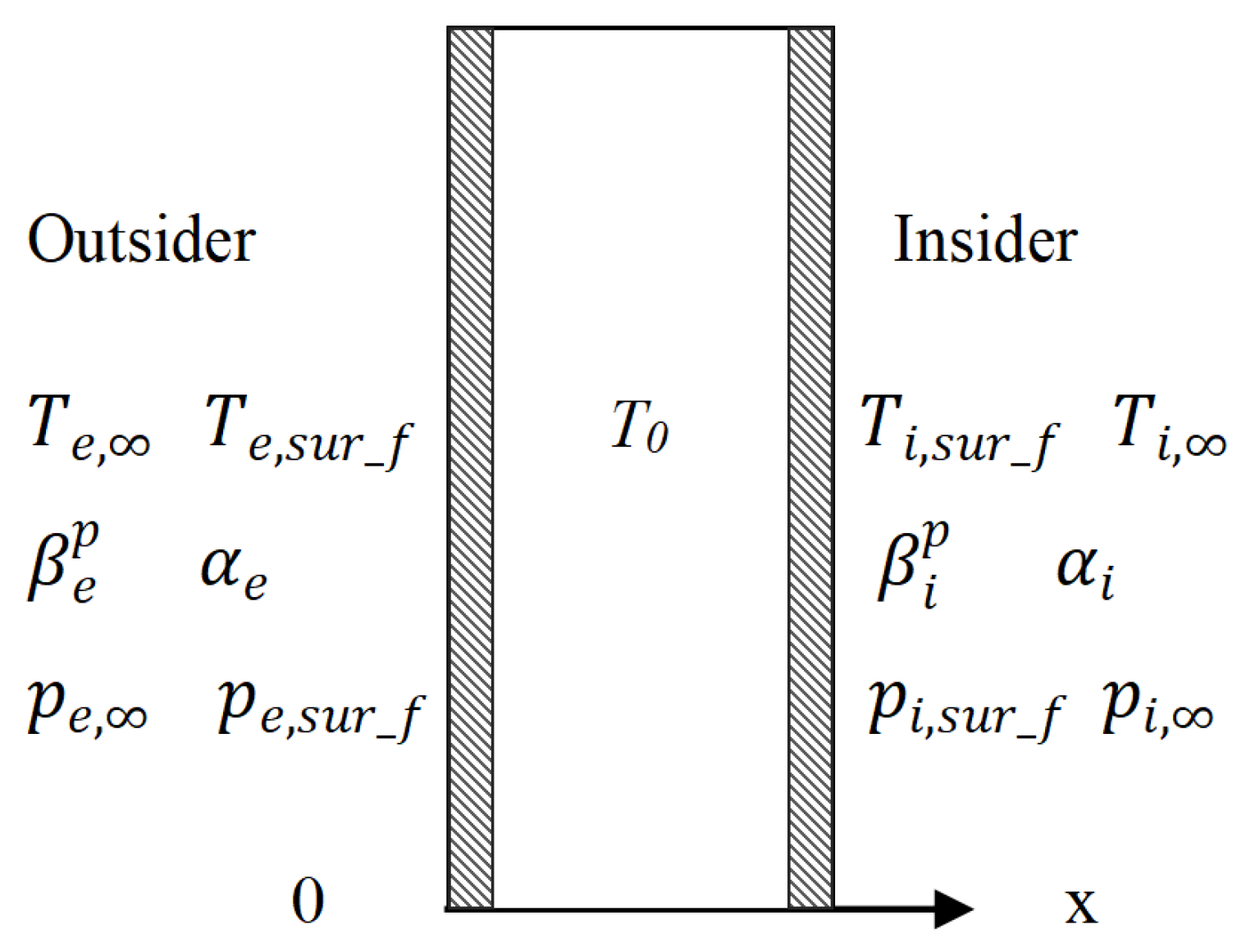
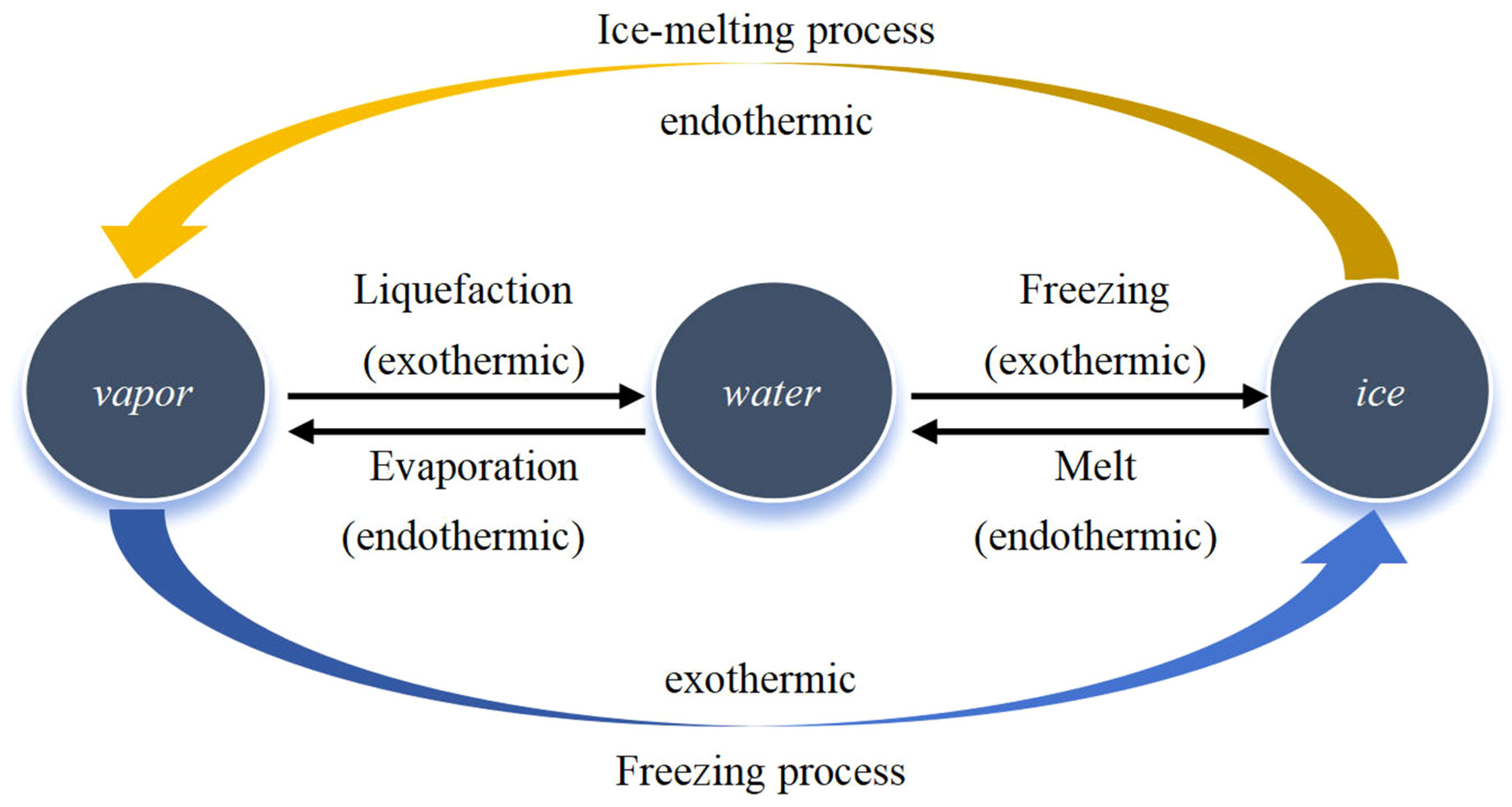


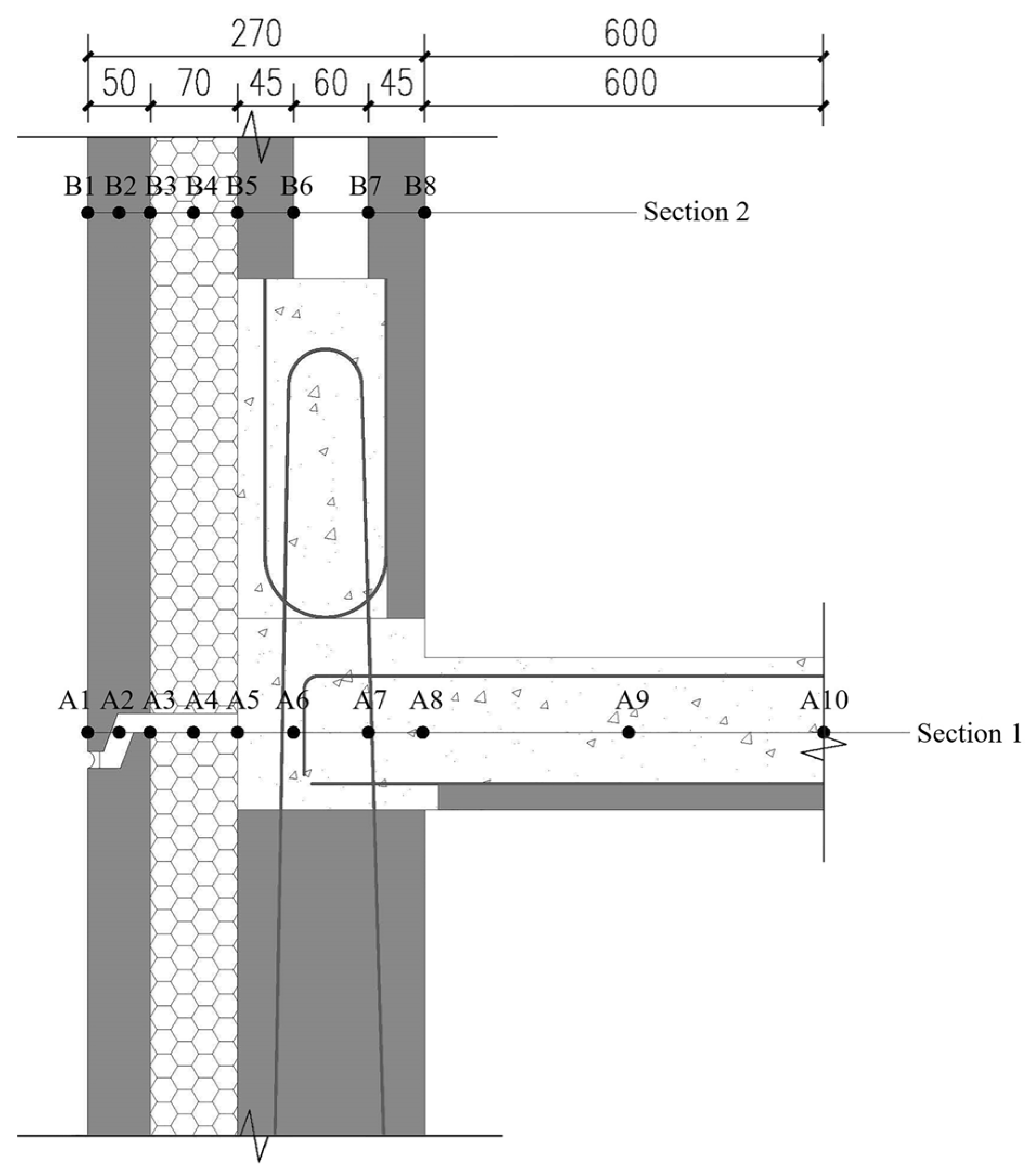
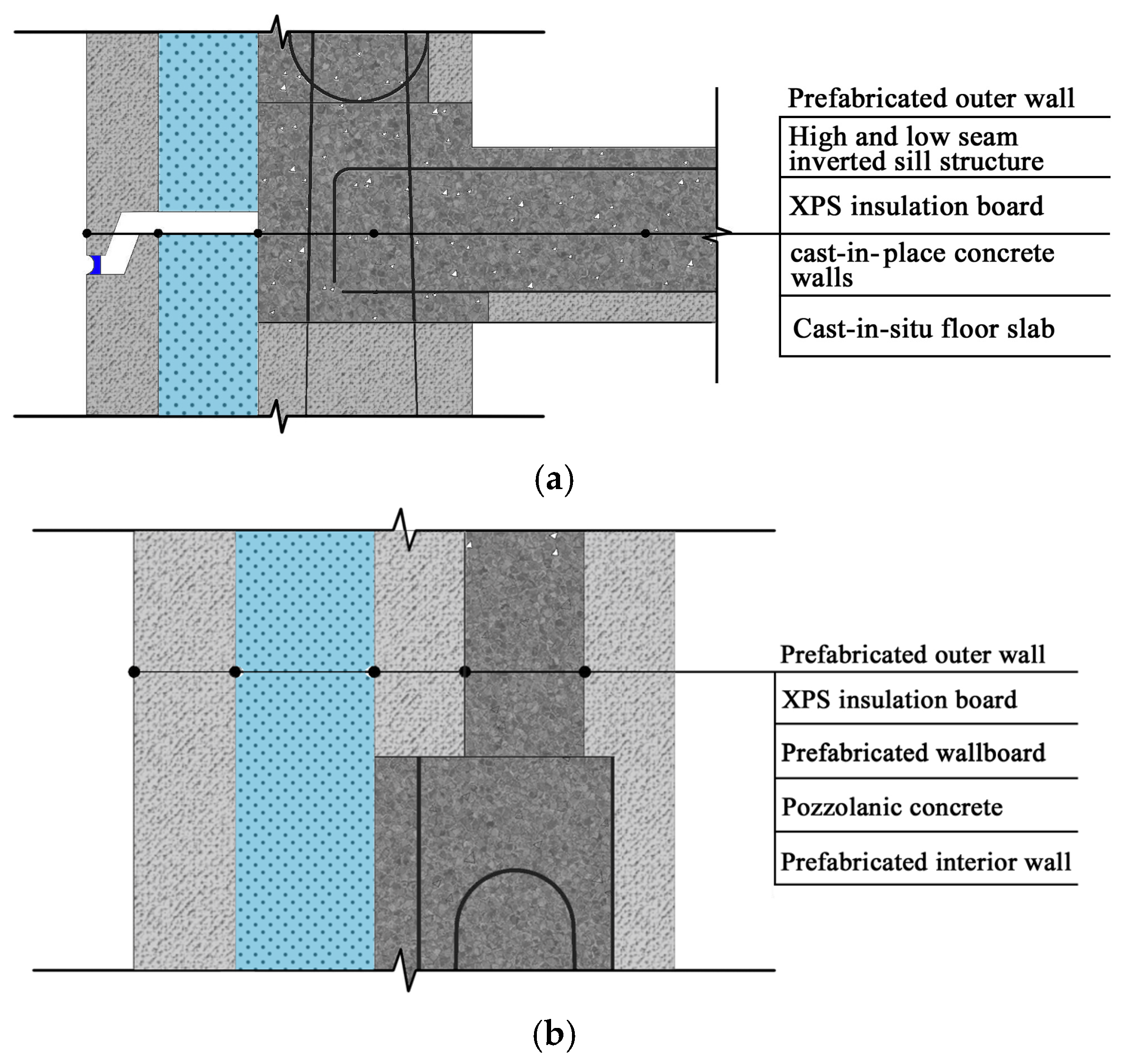
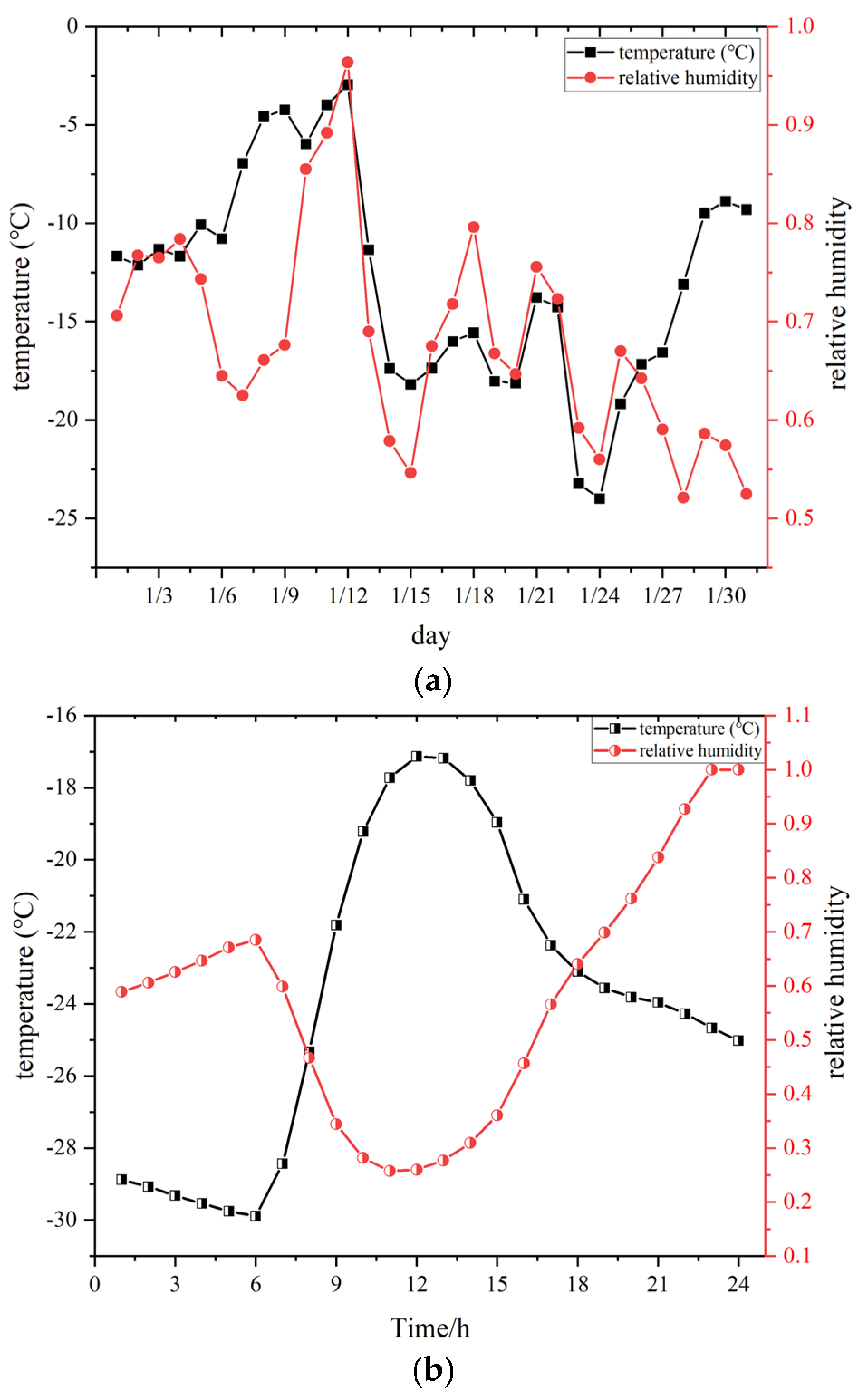
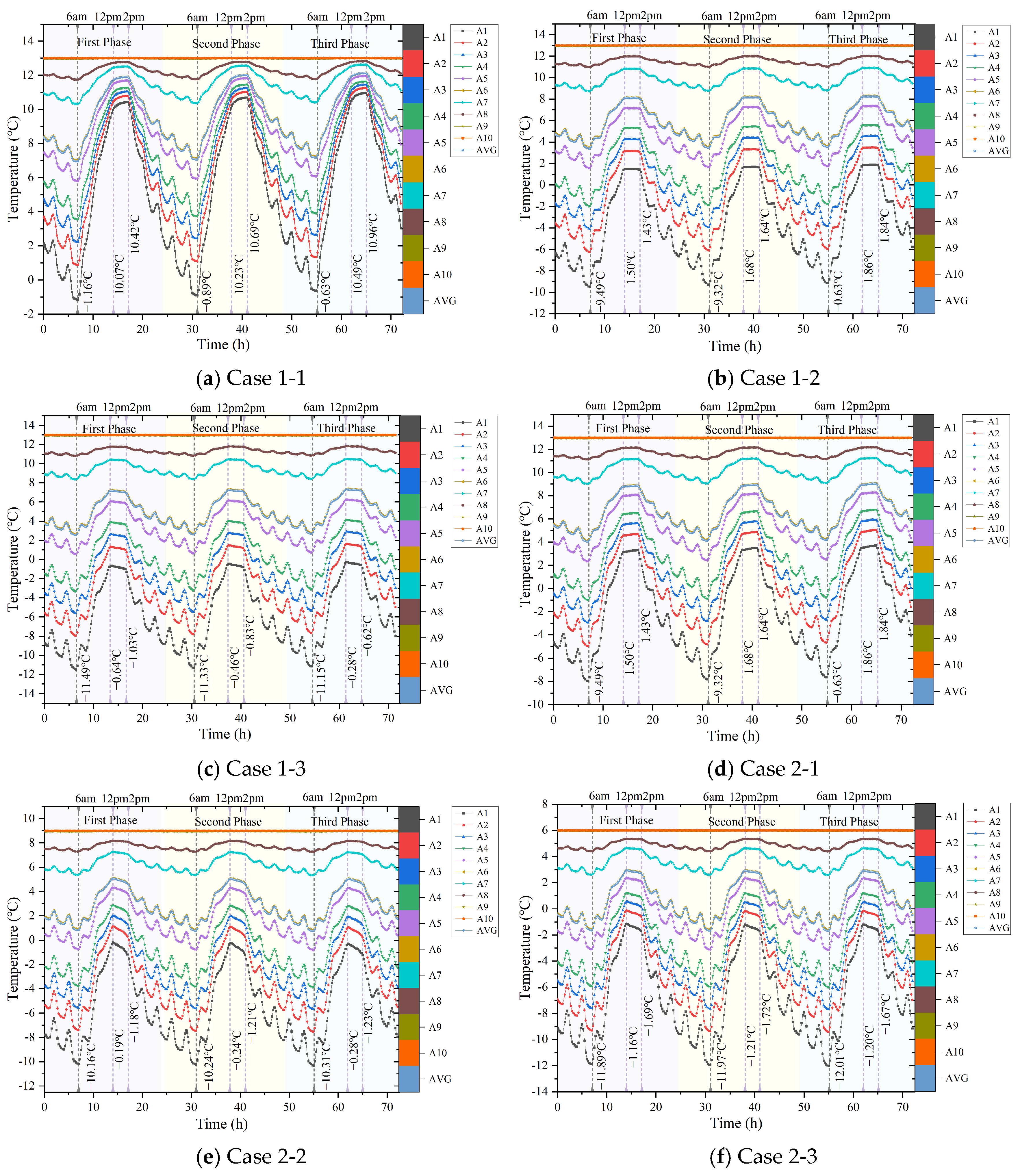
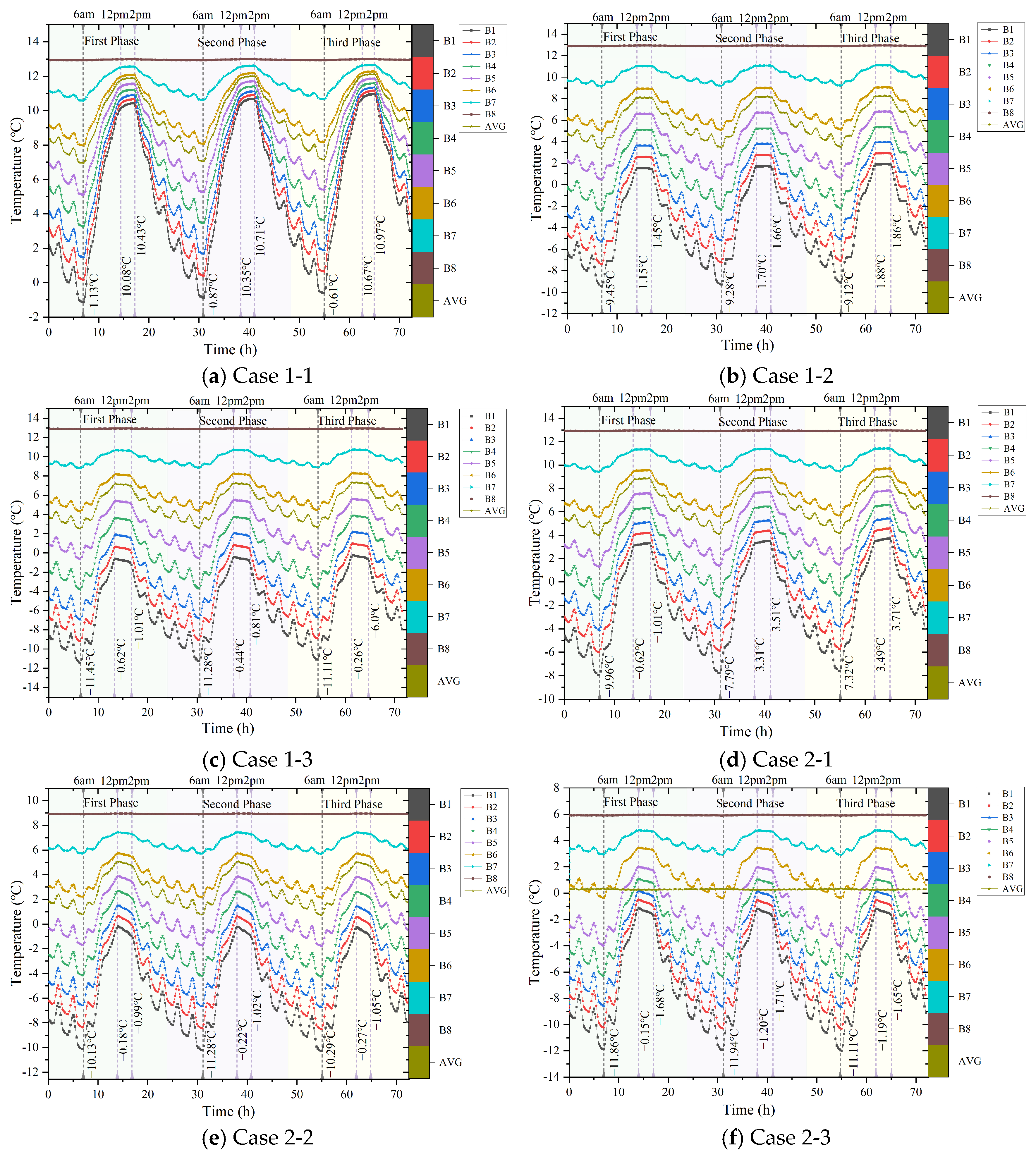
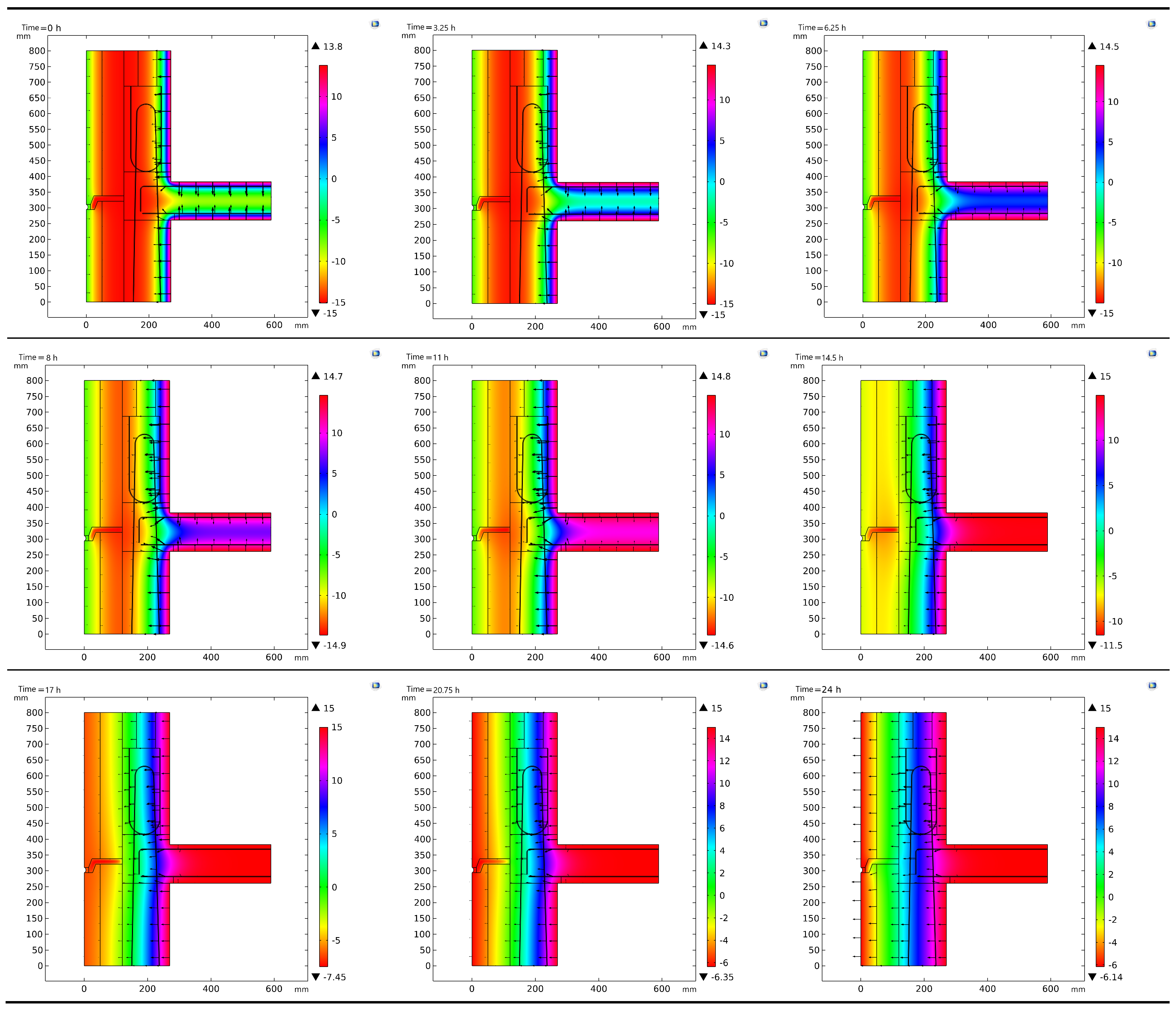
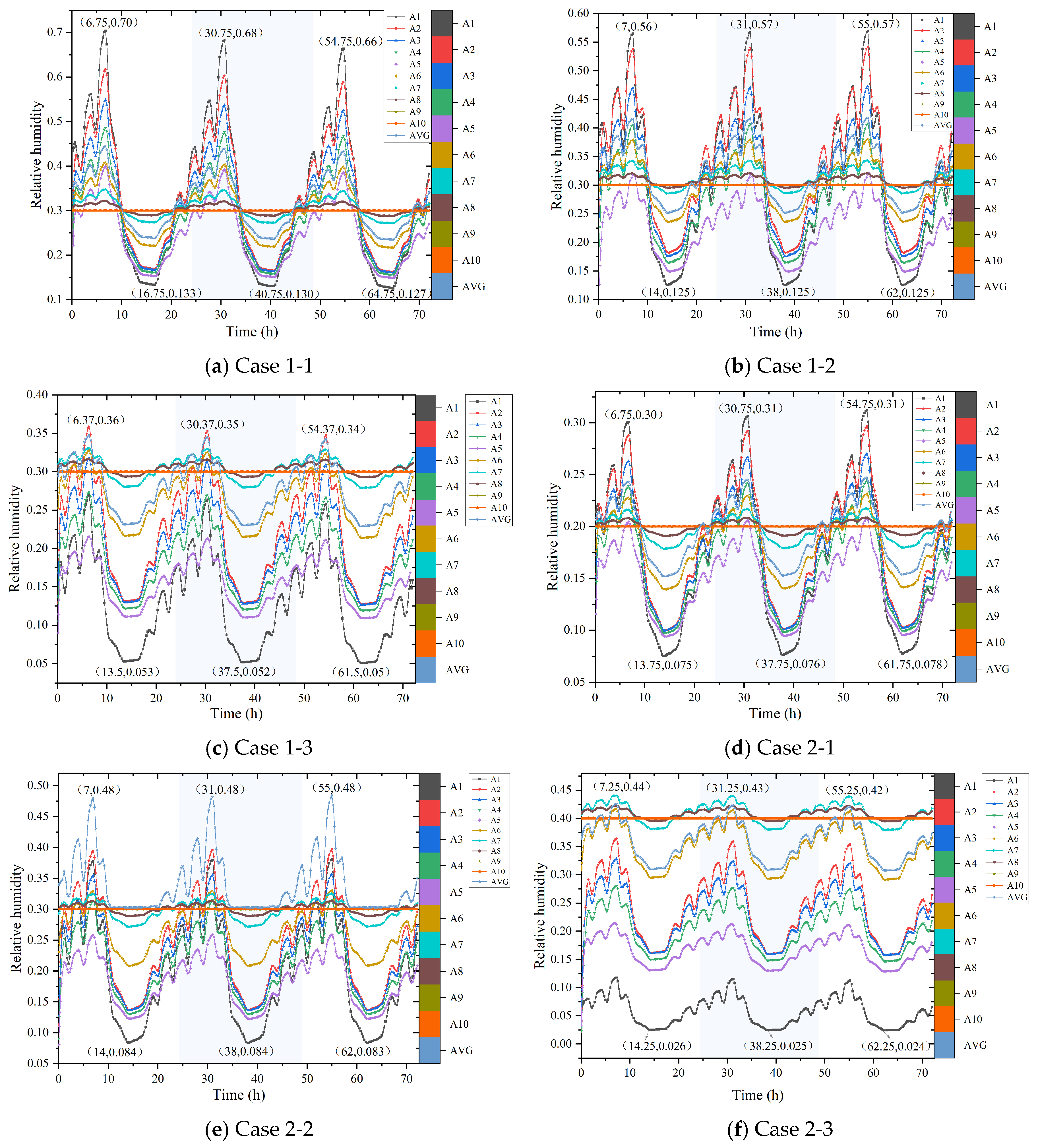
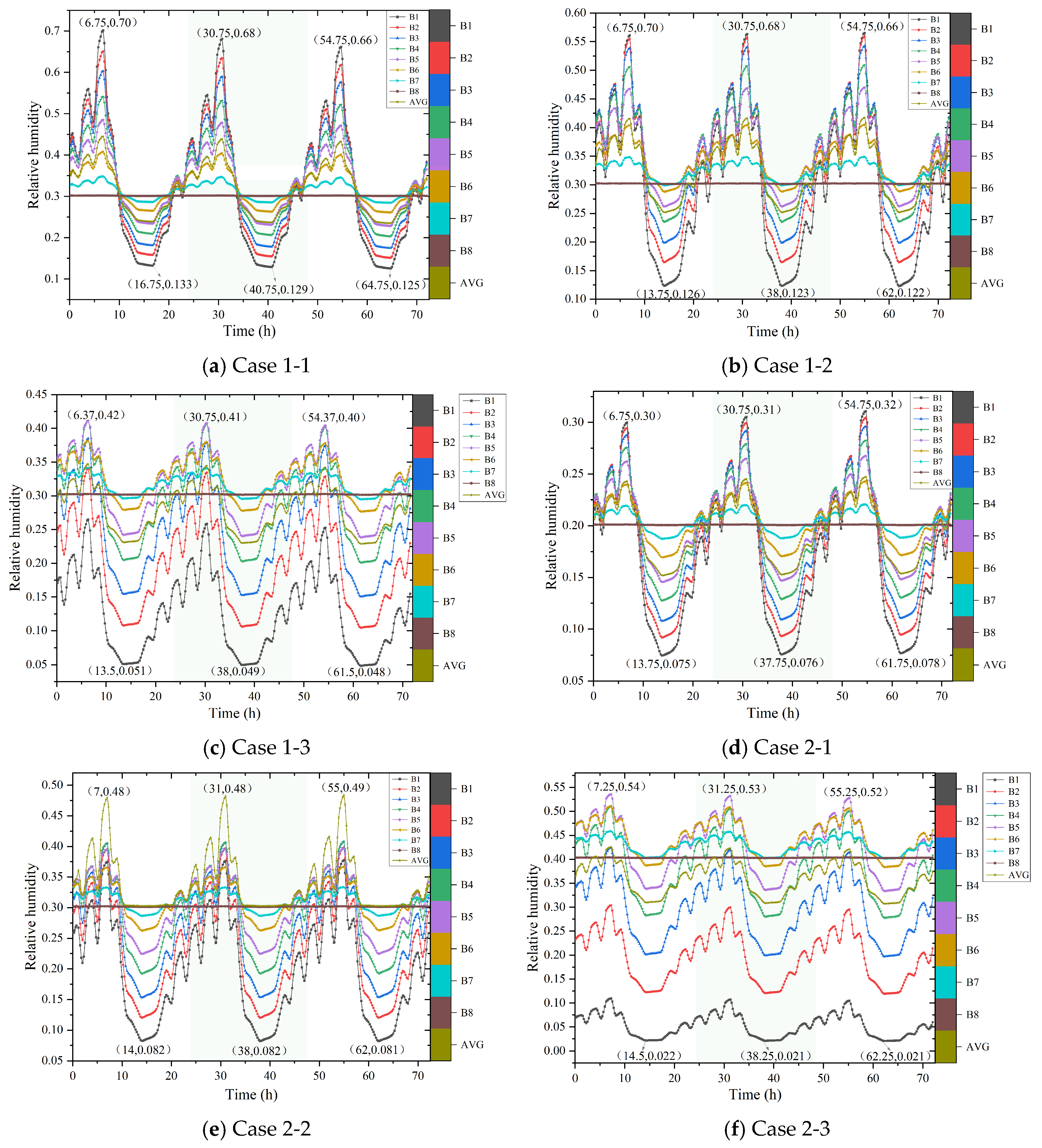
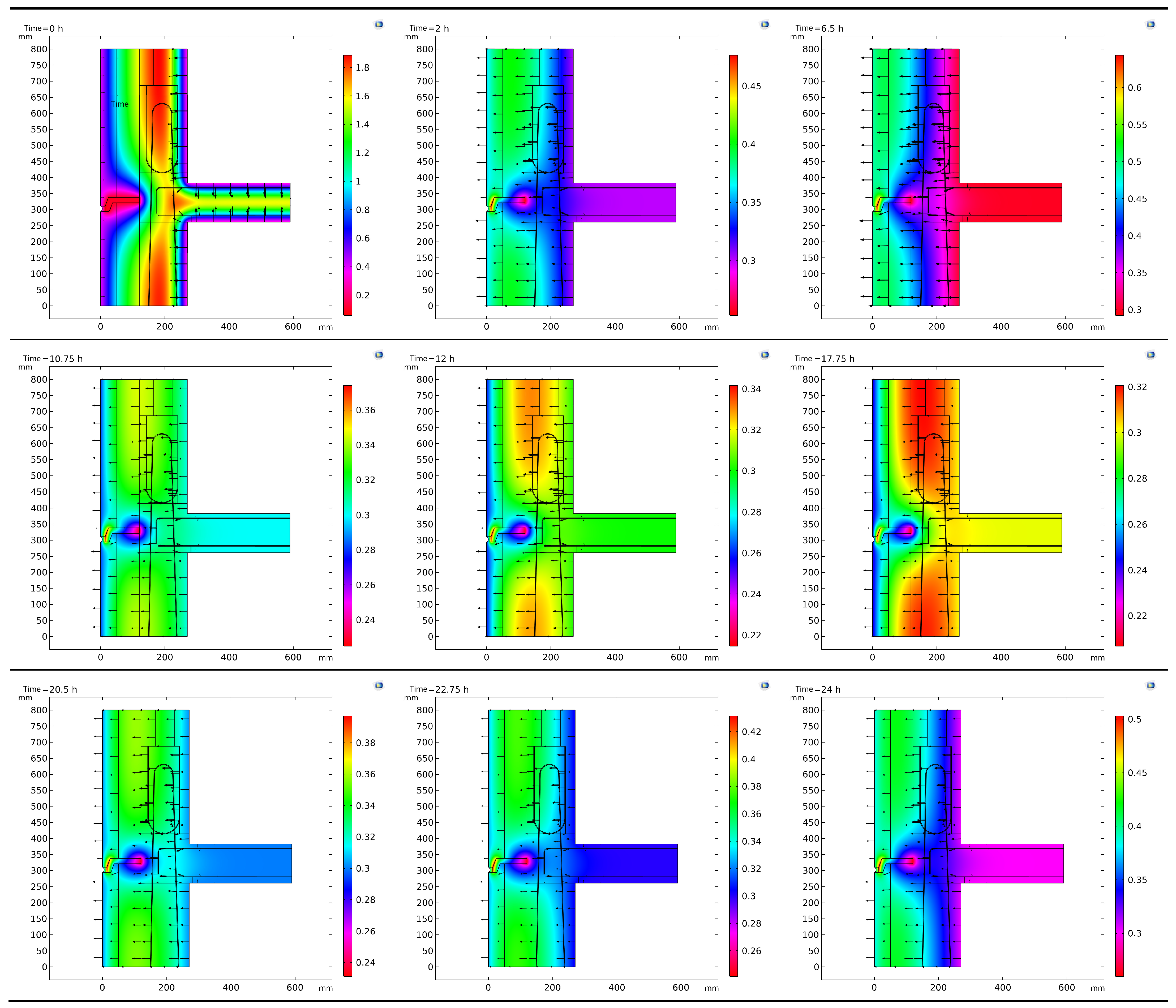


| Heat and Moisture Parameters | |
|---|---|
| Sorption isotherm (kg/m3) | |
| Vapor permeability (s) | |
| Liquid water permeability (s) | exp − 73)5) |
| Thermal conductivity [W/(m∙K)] | |
| Specific heat capacity [J/(m3∙K)] | 2280 × 800 |
| Measuring Point | Thickness (mm) | Structure | Material |
|---|---|---|---|
| A1 | 0 | Surface of exterior wall | Aerated concrete |
| A2 | 25 | High and low seam inverted sill structure | Air |
| A3 | 50 | Prefabricated outer wall—insulation layer | Aerated concrete—XPS insulation |
| A4 | 85 | High and low joints—insulation layer | XPS insulation material |
| A5 | 120 | Insulation layer—cast-in situ wall | XPS insulation—aerated concrete |
| A6 | 175 | Cast-in situ wall | Pozzolanic concrete |
| A7 | 225 | Rebar—cast-in situ wall | Rebar—pozzolanic concrete |
| A8 | 270 | Cast-in situ wall | Pozzolanic concrete |
| A9 | 400 | Cast-in situ floor slab | Pozzolanic concrete |
| A10 | 600 | Cast-in situ floor slab | Pozzolanic concrete |
| Measuring Point | Thickness (mm) | Structure | Material |
|---|---|---|---|
| B1 | 0 | Surface of exterior wall | Aerated concrete |
| B2 | 25 | Prefabricated outer wall | Aerated concrete |
| B3 | 50 | Prefabricated outer wall—insulation layer | Aerated concrete—XPS insulation |
| B4 | 85 | Insulation layer | XPS insulation material |
| B5 | 120 | Insulation layer—prefabricated wallboard | XPS insulation—aerated concrete |
| B6 | 175 | Prefabricated wallboard—cast-in situ wall | Aerated concrete—pozzolanic concrete |
| B7 | 225 | Cast-in situ wall—prefabricated interior wall | Pozzolanic concrete—aerated concrete |
| B8 | 270 | Interior wall surface | Aerated concrete |
| NO. | Grade | Material Composition(kg/m3) | Mix Proportion | |||
|---|---|---|---|---|---|---|
| Cement | Pozzolanic Ash Content | Sand | Water | |||
| 1 | CL20 | 406 | 611 | 621 | 307 | 1:1.50:1.53:0.76 |
| 2 | CL25 | 404 | 589 | 705 | 290 | 1:1.46:1.75:0.72 |
| 3 | CL30 | 495 | 544 | 685 | 310 | 1:1.10:1.38:0.63 |
| Type | Thickness mm | Porosity | Thermal Conductivity W/(m∙K) | Dry Density kg/m3 | Specific Heat Capacity J/(kg∙K) | Water Vapor Permeability | Vapor Locking Factor |
|---|---|---|---|---|---|---|---|
| Prefabricated outer wall | 50 | 0.24 | 0.67 | 550 | 850 | 4.8 × 10−11 | 8 |
| XPS board | 70 | 0.05 | 0.041 | 34 | 1450 | 1.2 × 10−12 | 150 |
| Pozzolanic concrete | 70 | 0.38 | 0.42 | 1810 | 920 | 3.47 × 10−11 | 12 |
| Rebar | 6 | 0.005 | 58.1 | 7800 | 460 | —— | —— |
| Prefabricated interior wall | 150 | 0.24 | 0.77 | 700 | 850 | 4.8 × 10−11 | 8 |
| Lime cement mortar | 50 | 0.25 | 0.87 | 1700 | 1050 | 1.2 × 10−11 | 40 |
| Reinforced concrete | 70 | 0.267 | 1.74 | 2500 | 920 | 4.8 × 10−11 | 10 |
| Simulation Group | Outdoor Parameters | Indoor Parameters | |||
|---|---|---|---|---|---|
| Temperature /°C | Relative Humidity /% | Temperature /°C | Relative Humidity /% | ||
| Group 1 | 1-1 | 0 | 60 | 15 | 30 |
| 1-2 | −10 | 60 | 15 | 30 | |
| 1-3 | −20 | 60 | 15 | 30 | |
| Group 2 | 2-1 | −10 | 40 | 15 | 20 |
| 2-2 | −15 | 60 | 10 | 30 | |
| 2-3 | −30 | 70 | 5 | 40 | |
| Working Condition | Temperature Changes | Measurement Points | |||||||||
|---|---|---|---|---|---|---|---|---|---|---|---|
| A1 | A2 | A3 | A4 | A5 | A6 | A7 | A8 | A9 | A10 | ||
| Case 1-1 | Peak arrival time | 17 h | 17 h | 17 h | 17 h | 17 h | 17 h | 17 h | 16.75 h | 17 h | 17 h |
| Temperature/°C | 10.42 | 10.79 | 11.04 | 11.28 | 11.69 | 11.91 | 12.51 | 12.77 | 13.02 | 13.17 | |
| Change amplitude/°C | 11.58 | 9.91 | 8.8 | 7.72 | 5.88 | 4.90 | 2.19 | 1.03 | 0.24 | 0.12 | |
| Case 1-2 | Peak arrival time | 16 h | 16 h | 16 h | 16 h | 16 h | 16 h | 16 h | 15.75 h | 13.5 h | 14 h |
| Temperature/°C | 1.50 | 3.15 | 4.26 | 5.34 | 7.16 | 8.14 | 10.82 | 11.98 | 12.95 | 13.15 | |
| Change amplitude/°C | 10.99 | 9.40 | 8.35 | 7.32 | 5.58 | 4.65 | 2.08 | 1.06 | 0.13 | 0.06 | |
| Case 1-3 | Peak arrival time | 14 h | 14 h | 14 h | 14 h | 14 h | 14 h | 14 h | 14 h | 14 h | 13.25 h |
| Temperature/°C | −0.65 | 0.89 | 1.91 | 2.91 | 4.59 | 5.50 | 7.98 | 9.05 | 9.76 | 10.10 | |
| Change amplitude/°C | 10.85 | 9.28 | 8.24 | 7.23 | 5.51 | 4.59 | 2.06 | 0.96 | 0.93 | 0.10 | |
| Case 2-1 | Peak arrival time | 17 h | 17 h | 17 h | 17 h | 17 h | 17 h | 16.75 h | 16.75 h | 14 h | 17 h |
| Temperature/°C | 3.28 | 4.68 | 5.62 | 6.53 | 8.07 | 8.89 | 11.16 | 12.14 | 13.00 | 13.00 | |
| Change amplitude/°C | 11.28 | 9.65 | 8.57 | 7.51 | 5.73 | 4.77 | 2.14 | 1.00 | 0.61 | 0.02 | |
| Case 2-2 | Peak arrival time | 14 h | 14 h | 14 h | 14 h | 14 h | 14 h | 14 h | 14 h | 14 h | 13.25 h |
| Temperature/°C | −0.19 | 1.13 | 2.01 | 2.88 | 4.33 | 5.11 | 7.26 | 8.18 | 8.97 | 9.18 | |
| Change amplitude/°C | 9.97 | 8.53 | 7.58 | 6.64 | 5.06 | 4.22 | 1.89 | 0.89 | 0.34 | 0.19 | |
| Case 2-3 | Peak arrival time | 14 h | 14 h | 14 h | 14 h | 14 h | 14 h | 14 h | 14 h | 14 h | 13 h |
| Temperature/°C | −1.16 | −0.13 | 0.56 | 1.23 | 2.36 | 2.97 | 4.64 | 5.36 | 6.00 | 6.21 | |
| Change amplitude/°C | 10.73 | 9.18 | 8.15 | 7.15 | 5.45 | 4.54 | 2.03 | 0.95 | 0.26 | 0.21 | |
| Working Condition | Temperature Changes | Measurement Points | |||||||
|---|---|---|---|---|---|---|---|---|---|
| A1 | A2 | A3 | A4 | A5 | A6 | A7 | A8 | ||
| Case 1-1 | Peak arrival time | 17 h | 17 h | 17 h | 17 h | 17 h | 17 h | 16.75 h | 15.25 h |
| Temperature/°C | 10.43 | 10.66 | 10.90 | 11.23 | 11.56 | 12.09 | 12.56 | 12.99 | |
| Change amplitude/°C | 11.57 | 10.50 | 9.44 | 7.94 | 6.45 | 4.11 | 1.98 | 0.06 | |
| Case 1-2 | Peak arrival time | 16 h | 16 h | 16 h | 16 h | 16 h | 16 h | 14 h | 14 h |
| Temperature/°C | 1.52 | 2.58 | 3.63 | 5.11 | 6.59 | 8.92 | 11.04 | 12.94 | |
| Change amplitude/°C | 10.97 | 9.96 | 8.95 | 7.54 | 6.12 | 3.90 | 1.87 | 0.05 | |
| Case 1-3 | Peak arrival time | 14 h | 14 h | 14 h | 14 h | 14 h | 14 h | 14 h | 14 h |
| Temperature/°C | −0.63 | 0.35 | 1.33 | 2.70 | 4.07 | 6.23 | 8.18 | 9.95 | |
| Change amplitude/°C | 10.83 | 9.83 | 8.83 | 7.44 | 6.04 | 3.85 | 1.85 | 0.05 | |
| Case 2-1 | Peak arrival time | 17 h | 17 h | 17 h | 17 h | 17 h | 17 h | 17 h | 17 h |
| Temperature/°C | 3.30 | 4.19 | 5.09 | 6.34 | 7.59 | 9.56 | 11.34 | 12.95 | |
| Change amplitude/°C | 11.26 | 10.22 | 9.18 | 7.73 | 6.28 | 4.00 | 1.92 | 0.06 | |
| Case 2-2 | Peak arrival time | 14 h | 14 h | 14 h | 14 h | 14 h | 14 h | 14 h | 14 h |
| Temperature/°C | −0.18 | 0.67 | 1.51 | 2.70 | 3.88 | 5.74 | 7.43 | 8.95 | |
| Change amplitude/°C | 9.96 | 9.04 | 8.12 | 6.84 | 5.55 | 3.54 | 1.70 | 0.05 | |
| Case 2-3 | Peak arrival time | 14 h | 14 h | 14 h | 14 h | 14 h | 14 h | 14 h | 14 h |
| Temperature/°C | −1.15 | −0.49 | 0.17 | 1.09 | 2.01 | 3.46 | 4.78 | 5.96 | |
| Change amplitude/°C | 10.71 | 9.73 | 8.74 | 7.36 | 5.98 | 3.80 | 1.83 | 0.05 | |
| Working Condition | Relative Humidity Changes/% | Measurement Points | |||||||||
|---|---|---|---|---|---|---|---|---|---|---|---|
| A1 | A2 | A3 | A4 | A5 | A6 | A7 | A8 | A9 | A10 | ||
| Case 1-1 | Peak arrival time | 7 h | 7 h | 7 h | 7 h | 7 h | 7 h | 7 h | 7 h | 5.75 h | 2.75 h |
| Peak relative humidity/% | 70.36 | 61.72 | 54.85 | 48.59 | 39.90 | 40.83 | 34.76 | 32.20 | 31.56 | 31.09 | |
| Change amplitude/% | 57.02 | 44.85 | 38.18 | 32.46 | 24.59 | 18.74 | 7.39 | 3.26 | 1.56 | 0.12 | |
| Case 1-2 | Peak arrival time | 7 h | 7 h | 7 h | 7 h | 7 h | 7 h | 7 h | 6.75 h | 7 h | 7 h |
| Peak relative humidity/% | 56.59 | 55.26 | 47.71 | 40.66 | 38.50 | 34.68 | 32.26 | 31.01 | 30.76 | 30.42 | |
| Change amplitude/% | 44.01 | 35.93 | 29.25 | 23.54 | 13.94 | 5.50 | 2.39 | 1.01 | 0.62 | 0.21 | |
| Case 1-3 | Peak arrival time | 7 h | 7 h | 7 h | 7 h | 7 h | 7 h | 7 h | 7 h | 6 h | 5.75 h |
| Peak relative humidity/% | 26.96 | 35.87 | 31.79 | 27.35 | 21.56 | 32.78 | 33.05 | 31.64 | 31.09 | 30.56 | |
| Change amplitude/% | 21.66 | 22.74 | 18.81 | 15.11 | 10.41 | 11.14 | 5.02 | 2.27 | 1.14 | 0.52 | |
| Case 2-1 | Peak arrival time | 7 h | 7 h | 7 h | 7 h | 7 h | 7 h | 7 h | 7 h | 7 h | 7 h |
| Peak relative humidity/% | 30.07 | 28.77 | 26.31 | 23.90 | 20.44 | 22.81 | 21.61 | 20.80 | 20.05 | 20.03 | |
| Change amplitude/% | 22.54 | 18.75 | 16.31 | 14.11 | 11.00 | 8.85 | 3.75 | 1.70 | 0.44 | 0.98 | |
| Case 2-2 | Peak arrival time | 7 h | 7 h | 7 h | 7 h | 7 h | 7 h | 7 h | 7 h | 6 h | 5.75 h |
| Peak relative humidity/% | 37.76 | 39.45 | 35.47 | 31.40 | 25.83 | 32.95 | 32.46 | 31.40 | 31.28 | 30.83 | |
| Change amplitude/% | 29.37 | 25.71 | 21.84 | 18.28 | 13.51 | 12.09 | 5.27 | 2.50 | 2.08 | 0.72 | |
| Case 2-3 | Peak arrival time | 7 h | 7 h | 7 h | 7 h | 7 h | 7 h | 7 h | 7 h | 5.75 h | 5.5 h |
| Peak relative humidity/% | 11.78 | 36.40 | 32.82 | 28.03 | 21.17 | 41.71 | 44.05 | 42.25 | 41.35 | 40.96 | |
| Change amplitude/% | 9.25 | 20.26 | 16.74 | 13.03 | 8.08 | 12.26 | 5.94 | 2.71 | 1.34 | 0.84 | |
| Working Condition | Relative Humidity Changes/% | Measurement Points | |||||||
|---|---|---|---|---|---|---|---|---|---|
| A1 | A2 | A3 | A4 | A5 | A6 | A7 | A8 | ||
| Case 1-1 | Peak arrival time | 7 h | 7 h | 7 h | 7 h | 7 h | 7 h | 7 h | 6.25 h |
| Peak relative humidity/% | 70.15 | 65.09 | 60.31 | 54.12 | 48.50 | 40.77 | 34.81 | 30.17 | |
| Change amplitude/% | 56.92 | 49.28 | 42.19 | 33.15 | 25.10 | 14.28 | 6.17 | 0.07 | |
| Case 1-2 | Peak arrival time | 7 h | 7 h | 7 h | 7 h | 7 h | 7 h | 7 h | 7 h |
| Peak relative humidity/% | 56.12 | 56.67 | 55.63 | 52.55 | 48.47 | 41.46 | 35.30 | 30.27 | |
| Change amplitude/% | 43.78 | 39.38 | 34.45 | 27.38 | 20.64 | 11.44 | 4.77 | 0.09 | |
| Case 1-3 | Peak arrival time | 7 h | 7 h | 7 h | 7 h | 7 h | 7 h | 7 h | 6.75 h |
| Peak relative humidity/% | 26.48 | 34.05 | 38.50 | 41.15 | 41.11 | 38.17 | 34.15 | 30.27 | |
| Change amplitude/% | 21.39 | 23.27 | 23.06 | 20.63 | 16.89 | 10.25 | 4.54 | 0.10 | |
| Case 2-1 | Peak arrival time | 7 h | 7 h | 7 h | 7 h | 7 h | 7 h | 7 h | 7 h |
| Peak relative humidity/% | 29.96 | 29.43 | 28.73 | 27.55 | 26.22 | 23.98 | 21.92 | 20.11 | |
| Change amplitude/% | 22.49 | 20.24 | 17.96 | 14.78 | 11.67 | 7.04 | 3.20 | 0.06 | |
| Case 2-2 | Peak arrival time | 7 h | 7 h | 7 h | 7 h | 7 h | 7 h | 7 h | 6.75 h |
| Peak relative humidity/% | 37.46 | 39.53 | 40.49 | 40.49 | 39.43 | 36.54 | 33.28 | 30.31 | |
| Change amplitude/% | 29.22 | 27.50 | 25.16 | 21.24 | 16.99 | 10.28 | 4.63 | 0.12 | |
| Case 2-3 | Peak arrival time | 7 h | 7 h | 7 h | 7 h | 7 h | 7 h | 7 h | 6.75 h |
| Peak relative humidity/% | 10.95 | 30.38 | 42.44 | 51.05 | 53.58 | 51.11 | 45.84 | 40.40 | |
| Change amplitude/% | 8.78 | 18.15 | 22.31 | 22.74 | 19.74 | 12.40 | 5.52 | 0.14 | |
Disclaimer/Publisher’s Note: The statements, opinions and data contained in all publications are solely those of the individual author(s) and contributor(s) and not of MDPI and/or the editor(s). MDPI and/or the editor(s) disclaim responsibility for any injury to people or property resulting from any ideas, methods, instructions or products referred to in the content. |
© 2025 by the authors. Licensee MDPI, Basel, Switzerland. This article is an open access article distributed under the terms and conditions of the Creative Commons Attribution (CC BY) license (https://creativecommons.org/licenses/by/4.0/).
Share and Cite
He, L.; Zou, D. A Study on the Thermal and Moisture Transfer Characteristics of Prefabricated Building Wall Joints in the Inner Mongolia Region. Buildings 2025, 15, 2197. https://doi.org/10.3390/buildings15132197
He L, Zou D. A Study on the Thermal and Moisture Transfer Characteristics of Prefabricated Building Wall Joints in the Inner Mongolia Region. Buildings. 2025; 15(13):2197. https://doi.org/10.3390/buildings15132197
Chicago/Turabian StyleHe, Liting, and Dezhi Zou. 2025. "A Study on the Thermal and Moisture Transfer Characteristics of Prefabricated Building Wall Joints in the Inner Mongolia Region" Buildings 15, no. 13: 2197. https://doi.org/10.3390/buildings15132197
APA StyleHe, L., & Zou, D. (2025). A Study on the Thermal and Moisture Transfer Characteristics of Prefabricated Building Wall Joints in the Inner Mongolia Region. Buildings, 15(13), 2197. https://doi.org/10.3390/buildings15132197





